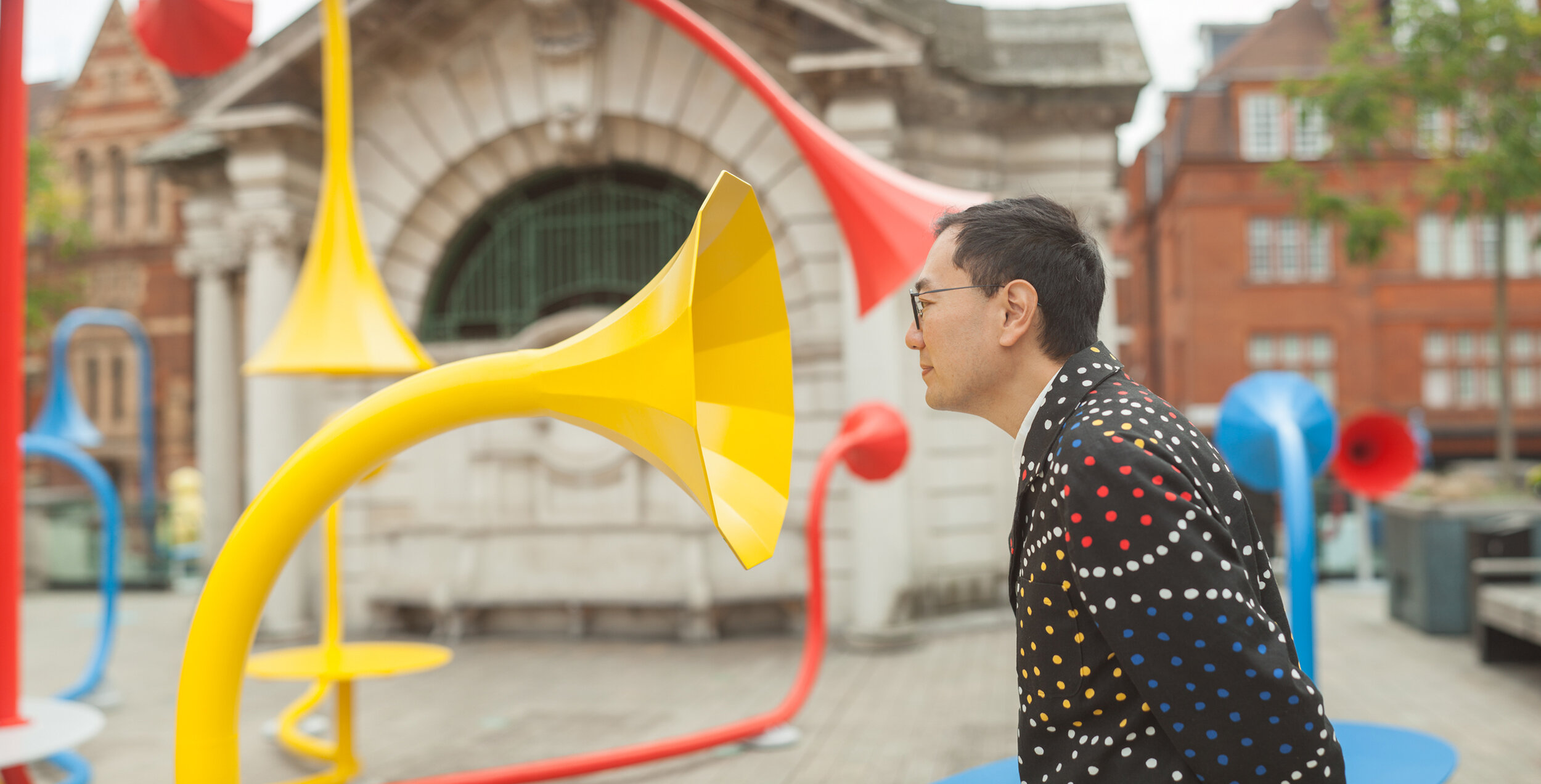What Will the Neighbours Say?
Sonic Bloom, installed in Brown Hart Gardens (image: Alberto Balazs).
A little way into my interview with the sound designer Yuri Suzuki, he mentioned a slight hiccough with a recent work. We were discussing Sonic Bloom, an installation that Suzuki had opened in Mayfair’s Brown Hart Gardens a few days previously, when he suddenly dropped into conversation that there had been a problem. “We had a complaint from a neighbour.”
This surprised me. Sonic Bloom is lovely. It’s a set of primary coloured metal pipes that erupt from the ground like a tangle of kraken arms, waggling mischievously up and over the terraced garden in which it swims. Each arm features gramophone-style bells at both ends, with the pipe bent such that one end rises up and over, arching down like a cloche you can clamber into, while the other snakes around the floor before sitting up primly, invitingly positioned at lip-level. The idea is that each pipe acts as a whispering gallery: what is spoken into one end transmits perfectly out the other. Like I said, lovely. What kind of monster could object to that?
Suzuki demonstrating Sonic Boom’s audio effects (image: Alberto Balazs).
Well, turns out the complaint had legs – at least on the surface of things. “They said that the work looks quite noisy and they were worried about noise pollution,” says Suzuki, who admits that the critic may have been on to something. “It looks like it promises quite a lot of sound,” he notes. For an audio installation, “It works well as a communication.”
“I was interested in using acoustic sculpture as a way of bonding communities.”
Concerned of Brown Hart Gardens probably had a point. The neighbourhood is just off Oxford Street, but is itself rather a secluded enclave. Owned by the Grosvernor Group, the gardens were built in 1906 above the old Duke Street electricity substation, which was covered by the architect Stanley Peach with a domed gazebo and steps at either end. It’s a beautiful space, but one that many people don’t seem to know about or use. Which perhaps suits the neighbours – quiet spaces in Central London are few and far between. Suzuki’s commission, which was curated by Anne-Laure Pingreoun of Alter-Projects, was designed to help build community through public art and encourage greater use. “It’s a bit of a strange area as it’s sort of residential, but not 100 per cent residential,” Suzuki says. “We had to respect that aspect. I was interested in using acoustic sculpture as a way of bonding communities.”
Image: Alberto Balazs.
What better to invite public participation than something loud, playful and inviting? “I had a good discussion with Anne about how public sculpture can often be a local government paying £100k to make a bronze statue, which doesn’t really have a function for the community at all,” Suzuki says. “So instead of that, why not make a functional, meaningful thing? That was a trigger point.” And Sonic Bloom certainly meets that brief. It’s energetic, chaotic and, visually, as noisy as they come – it looks like something from Super Mario, which is never a bad thing. Acoustically, however, it’s rather soft and delicate. The pipes carry sound perfectly, but the experience is not deafening or obtrusive – particularly after the period of lockdown, there is something intimate about hearing someone’s voice pass down the pipe and into your ear. The neighbour needn’t have worried.
“Human beings need a more sensory experience to get communication.”
Yet their concern seems testament to Suzuki’s work. While he is righty celebrated as a pioneer of sound design, his work with audio has always been supported by a keen visual sense – as well as playing with sound itself, Suzuki is good at physicalising his medium. “Sound experiences are totally invisible and hard to present in a visual way, he says. “I have always admired Christian Marclay’s work and the way he expresses sound through sculpture and visual presence. There are many sound artists who just focus on sound and speakers installed in a space. That doesn’t excite me much. Human beings need a more sensory experience to get communication.”
A recurring motif, standing front and centre in Sonic Bloom, is those gramophone bells, which Suzuki describes as “horns”. The form has appeared in The Welcome Chorus at Margate’s Turner Contemporary, Sonic Playground at Atlanta’s High Museum of Art, and the tricked out London Black Cab that Suzuki created for Capital Headphone’s ‘Make The City Sound Better’ campaign. His relationship with the horn, Suzuki explains, began with the White Noise Machine he created for New Delhi’s Silent City Installation in 2010. “The horn is very iconic,” he says, “and my first meeting with it came from my stay in India. I’ve continued to use it since then.” In Silent City, Suzuki’s machine generated white noise to cancel out the ambient sounds of New Delhi, but with Sonic Bloom the horns operate to amplify the surrounding city and create moments of connection in Brown Hart Gardens. Here, the horns aren’t particularly noisy, but Suzuki notes that “it’s easy to imagine sound coming through there”. Their visual cacophony is a promise of more vibrant times ahead.
Words Oli Stratford




